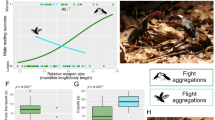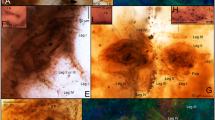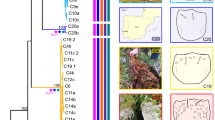Abstract
Male morph was found to be determined in different ways in two species of acarid mites within which morphologically distinct fighter and nonfighter males occur. Fighter males sired significantly larger proportions of fighters in comparison to nonfighter males in Rhizoglyphus robinii, but not in Caloglyphus berlesei. The genetic mechanism of male morph determination in R. robinii remains unclear: neither single-locus nor polygenic models fit the results of the crosses. Mites fed on a poor diet during development were less likely to develop into fighters in both species. However, increased density inhibited the development of fighters in C. berlesei, but not in R. robinii.
Similar content being viewed by others
Article PDF
References
Bradshaw, W E. 1973. Homeostasis and polymorphism in vernal development of Chaoborus americanus. Ecology, 54, 1247–1259.
Dominey, W J. 1984. Alternative mating tactics and evolutionary stable strategies. Am Zool, 24, 385–396.
Falconer, D S. 1989. Introduction to Quantitative Genetics 3rd ed. Longman Scientific & Technical, Harlow, Essex.
Fisher, R A, and Mather, K. 1943. The distribution of style length in Lythrum salicaria. Ann Eugen, 12, 1–23.
Foa, A. 1919. Studio del polimorfismo unisessuale del Rhizo-lyphus echinopus. Memoria Accad Pontificia Nuovi Lincei Roma Ser. V, 12, 3–109.
Gerson, U, Capua, S, and Thorens, D. 1983. Life history and life tables of Rhizoglyphus robinii Cleparede (Acari: Astigmata: Acaridae). Acarologia, 24, 439–448.
Hughes, A M. 1976. The Mites of Stored Food and Houses Technical Bulletin No. 9. Ministry of Agriculture, Fisheries and Food, London.
Moran, N A. 1992. The evolutionary maintenance of alternative phenotypes. Am Nat, 139, 971–989.
Mosteller, F, and Tukey, J W. 1949. The uses and usefulness of binomial probability paper. J Am Stat Ass, 44, 174–212.
Oliver, J H, Jr. 1977. Cytogenetics of mites and ticks. Ann Rev Ent, 22, 407–429.
Radwan, J. 1992. The influence of a crowded environment on the size of males of Caloglyphus berlesei (Acari: Acaridae). Int J Acarol, 18, 67–68.
Radwan, J. 1993a. The adaptive significance of male polymorphism in the acarid mite Caloglyphus berlesei. Behav Ecol Sociobiol, 33, 201–208.
Radwan, J. 1993b. Kin recognition in the acarid mite, Caloglyphus berlesei — negative evidence. Anim Behav, 45, 200–202.
Timms, S, Ferro, D N, and Emberson, R M. 1981. Andropolymorphism and its heritability in Sancassania berlesei (Michael) (Acari: Acaridae). Acarologia, 22, 391–398.
Timms, S, Ferro, D N, and Waller, J B. 1980. Suppression of production of pleomorphic males in Sancassania berlesei (Michael) (Acari: Acaridae). Int J Acarol, 6, 91–96.
Woodring, J P. 1969. Environmental regulation of andropolymorphism in Tyroglyphids (Acari). In: Evans, G.O. (ed.) Proceedings of the 2nd International Congress of Acarology, pp. 433–440. Akademiai Kiado, Budapest.
Zar, J H. 1984. Biostatistical Analysis. Prentice-Hall, Engle-wood Cliffs, NJ.
Author information
Authors and Affiliations
Rights and permissions
About this article
Cite this article
Radwan, J. Male morph determination in two species of acarid mites. Heredity 74, 669–673 (1995). https://doi.org/10.1038/hdy.1995.91
Received:
Issue date:
DOI: https://doi.org/10.1038/hdy.1995.91
Keywords
This article is cited by
-
Small-scale genetic structure of populations of the bulb mite Rhizoglyphus robini
Experimental and Applied Acarology (2023)
-
Toward an understanding of the chemical ecology of alternative reproductive tactics in the bulb mite (Rhizoglyphus robini)
BMC Ecology and Evolution (2022)
-
Genomic evidence that a sexually selected trait captures genome-wide variation and facilitates the purging of genetic load
Nature Ecology & Evolution (2022)
-
Juvenile diet quality and intensity of sexual conflict in the mite Sancassania berlesei
BMC Evolutionary Biology (2020)
-
The role of genetic diversity in the evolution and maintenance of environmentally-cued, male alternative reproductive tactics
BMC Evolutionary Biology (2019)



